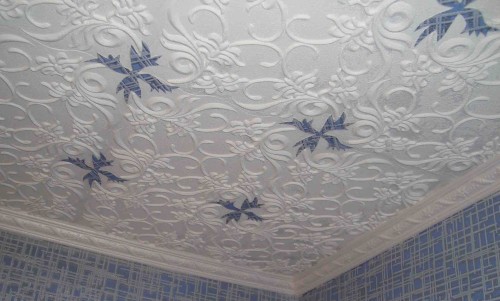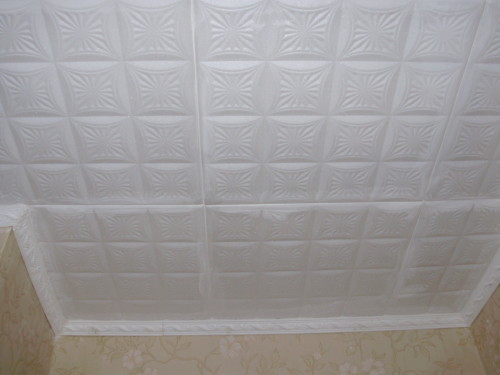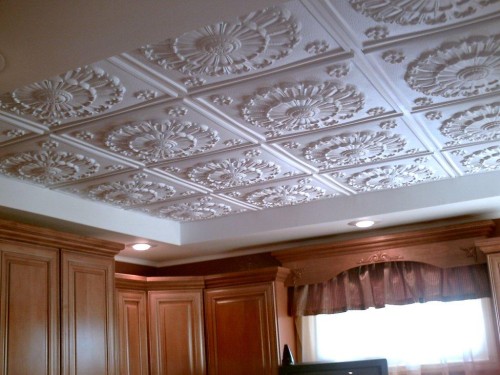Some time ago, the owners only blenel the ceilings so that they look neutrally and did not cause any negative views. Now the ceiling surface is actively decorated, and very often the original materials that appeared on the market only a couple of years ago.
Content
With the help of a high-quality ceiling finish, a visual increase in space can be achieved. It is also quite realistic to create a fabulous atmosphere. There are many materials on sale with various drawings and textures on your surface. Such products will allow a new one to take a look at the issue of ceiling.
Often today for finishing the ceiling tile made of polystyrene foam. This material is incredibly practical. It can be used in a wide variety of conditions. The appearance of such a tile depends only on the fancy of the manufacturer. Often the companies offer several dozen patterns of patterns that will definitely decorate the dwelling. As for the tile texture itself, there are also a lot of options here. To the process of sticking tiles can be approached creatively. You can, for example, combine different types of material to create an original composition.
As for the process of sticking tiles, there is nothing difficult here. You just need to follow technology and work efficiently.
In this article, we will consider the basic information associated with the ceiling tiles, as well as analyze the technology of sticking this construction resource.
The main features of the ceiling tiles made of polystyrene foam
Most often, people choose polystyrene tiles, simply based on the appearance of the material. In fact, it is also necessary to pay attention to some other aspects that can actually become important in the process of using tiles.
First you need to pay attention to the edges of the material. The polystyrene foam must be solid and durable. If at the edges of the tile there are crumbs or some other flaws, this material is unsuitable for use. He can simply crumble after a couple of weeks you can stick. In addition, polystyrene materials consist of small grains. The quality of this construction resource can be checked very simple. Just just look in the section of grains. If large, and small grains are present in the material, it is better not to take such a tile. Such material does not differ in high quality. Accordingly, the tile can easily break up during the blending process.
Also, when buying tiles from expanded polystyrene, you should pay attention to the strength of products. The truly high-quality products never happen to never break, even considering the fact that the polystyrene foam itself is far from the most durable material. If we have a big tile, you can take one hand for its edge. The material will begin to bend a little, but the tile should not break. If cracks appear on polystyrene foaming, you can safely refuse such products, as it is poor quality.
In addition, when choosing a tile, you need to pay attention to its geometry. Very often, novice manufacturers are not seriously suitable for production technology, and ultimately, polystyrene tiles have not completely straight corners. Accordingly, a lot of problems associated with the docking of the material will arise during the installation. Of course, it is possible to arm a stationery knife and cut part of the tile, but then there will be problems with the coincidence of drawings and calculations related to the determination of the required amount of products. It is advisable to check everything right at the place of purchase and with good light. Often, the sellers themselves are trying to sell defective batch products, so it is necessary to check the quality of products in each purchased packaging.
Varieties of ceiling tile
When buying tiles for the ceiling, you need to pay attention to the fact that manufacturers often offer a variety of options for their products. By and large, the type of tile should not affect the material of the material mounting on the ceiling. At the same time, it should be borne in mind that the tiles produced in different ways differ only to the material thickness.
The extruded polystyrene tile is made by stamping large blocks of material. Accordingly, there is an opportunity to produce quite thin tiles, the thickness of which is often limited to 8 mm. If we do not need a large and bulk drawing on the ceiling, you can choose from the extruded tile. At the same time it has a modest weight, which allows you to be confident in a reliable fastening of the tile on the ceiling.
The extruded tile is produced by hot extrusion. Accordingly, such products have a smooth surface, as well as an attractive shine, which does not have other types of tiles. Often, extruded tiles are made with such a texture so that it looks outwardly resembled marble or other natural material. The choice of this product depends only on the range of manufacturers who often offer quite original solutions.
Well, the last type of polystyrene tile is an injection material. Production of this product occurs in such a way that special forms are filled with a certain set of raw materials (of course, not without the participation of polystyrene). Often, injection tiles have a deep relief, therefore the thickness of the product can reach 15 mm. This type of ceiling material is most often used in large and spacious premises, where a major relief of the tile will not be strongly rushed into the eyes.
Calculation of the volume of procurement of material
Before acquiring the material, we will need to conduct detailed calculations of the necessary volumes of tiles. To date, the ceiling material is very expensive, so it is too expensive to acquire excessive products. At the same time, you need to understand what to buy a pair of extra tiles, which can be useful for replacement, still makes sense.
First you need to know the room area, it is based on this information that we can preliminarily evaluate the required tile volume. Accordingly, we create a schematic image of the ceiling and blacks. Square sectors that will designate the location of the tile. Even if after calculations it became known to know the exact number of the required tiles, you need to purchase on a couple of products more products.
If the ceiling is irreversible, then you can encounter a variety of problems. First of all, problems can be associated with the complexity of the installation of the material. It must be cut and combined with other units of tiles on the ceiling. At the edges of the ceiling flaws can be hidden using a plinth, and throughout the rest of the area will need to carefully monitor the coincidence of tiles. In case of errors, you can easily replace the material to a new one.
Very often a full ceiling markup is carried out, which allows the most economically to use the tile material. To do this, you need to spend two lines of the cross on the cross, and from the central point to begin shots of the material. With this scenario, we will use significantly less tiles than with any other method of markup. However, on the edges of the ceiling, the cropped parts of the material will still have to be mounted. Most often, the central point in the room is the chandelier. It is necessary to repel from this object when the ceiling markup occurs or the tile installation directly.
If possible, also should be selected in such a way that it does not need to be cut into parts. However, often the ceiling tile has a standard size - 50x50 cm.
In addition, you need to choose high-quality glue for fastening tiles. Often, in such cases, classic "liquid nails" are used. They practically do not have drawbacks, and if necessary, it is possible to remove the tile from the surface of the ceiling without much effort.
Tile installation process
Now the most responsible stage of work is coming - sticking tiles. It should be understood that it is better to not allow mistakes, as they may be too expensive. The tile material itself can be very expensive, and with some installation errors it will need to simply sink from the ceiling, and in the future it will not work damaged.
Starting the installation of the tile is needed from the central point. Here we need to take 4 units of material and apply "liquid nails". The glue must quickly dry up so that it can be used for mounting. Literally in a few minutes we take the tile and one of the corners we apply to the center of the ceiling. To be sure that we correctly placed the tile, you must use the markup applied by a pencil. If you make a blowing "on the eye", then it is unlikely to avoid problems.
Next, you need to glue the remaining 3 tiles that will be central on the ceiling. It should be focused on the fact that no indents and gaps between tiles should be, otherwise you can move greatly from the initial markup of the ceiling. Next, the tile is installed around the already glued material.
Now, when most of the ceiling is covered with polystyrene tiles, it is necessary to accommodate the material on the edges of the room. Often here you need to cut a tile so that it fit into the limited space room. First, you need to qualitatively make measurement of the remaining gaps on the ceiling, and then cut the tile cutting. In order to cut the material, you need to use a construction or stationery knife.
As already mentioned, it is necessary to cut the material in such a way that uneven edges or a gap formed between tiles and a wall can be easily hidden using a plinth. The plinths themselves are better to choose after the installation of polystyrene tiles is made. The essence of this decision is that after all the works we will clearly see exactly what the clearance is available between the edge of the tile and the wall. Perhaps we will need to make a choice in favor of quite large plinths, and only they will help hide the obtained problem areas.
Also, problems may arise if we have twisted ceiling and walls. In such a situation, even the quality markup of the ceiling will not help. Fix the surface flaws is very difficult, for this you need to involve specialists. However, even before installing the tile, all these factors should be taken into account. For example, if we have deformed walls, you need to cut the plinths into small parts so that they can be easily mounted. With the ceiling everything is much more difficult. After installing the polystyrene tile immediately demonstrates all flaws of the surface. In addition, the twisted ceiling may complicate the material fastening process.
Restrictions on the use of polystyrene tiles
Despite the fact that polystyrene tile is almost universal, do not forget about restrictions. Unfortunately, experts do not recommend using this type of tile on most industries. First of all, it is associated with low fire safety. When fireing, the polystyrene tile will immediately begin to actively spread the fire. Moreover, it is far from the secret that during the fire, the polystyrene tile begins to highlight a poisonous smoke, which may even cause the death of tenants.
In addition, the material is not recommended to use in children's rooms. Indeed, polystyrene is a product of the chemical industry. By itself, this polymer is not dangerous, but the child, playing in his room, can become a victim of non-environmental material. During the period of operation, polystyrene still distinguishes a number of unsafe substances that will easily damage the growing organism. Thus, it is better to look at some kind of natural material, even if it costs much more expensive than polystyrene.























